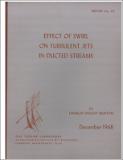Effect of swirl on turbulent jets in ducted streams
Author(s)
Morton, Harmon Lindsay
Download09165925.pdf (6.001Mb)
Other Contributors
Massachusetts Institute of Technology. Gas Turbine Laboratory
Metadata
Show full item recordAbstract
An experimental and theoretical program of research has been carried out to determine the effect of swirl on the mixing of a turbulent jet in a ducted stream. The term swirl is used to describe a flow pattern within the jet where mean streamlines are spirals. It has been found experimentally that the mixing rate of a turbulent jet with a surrounding stream can be increased by a factor of three due to the presence of swirl. Three dimensionless parameters, one of which is the jet nozzle to test section diameter ratio, have been used to describe the experimental results. The well-known integral technique has been used to predict the mean flow field of the turbulent jet in a ducted stream. Velocity profiles and turbulent eddy viscosity have been evaluated from turbulent free jet data. The increased mixing due to swirl has been explained in part by the adverse pressure gradient along the jet centerline associated with a decaying swirl and also by an increase in the magnitude of the Reynolds shear stresses within the jet. The calculation procedure divides the flow into two regions - one before the jet attaches to the wall and one after. Two possible correlations giving first order effects of swirl strength on local eddy viscosity are found to give good results for both the ducted jet and the free jet (a jet exhausting into a still fluid). Comparison of data with theory for the axial position of jet attachment is good for all cases studied.
Description
December 1968 Includes bibliographical references (leaves 46-47)
Date issued
1968Publisher
Cambridge, Mass. : Massachusetts Institute of Technology, Gas Turbine Laboratory, [1968]
Series/Report no.
GTL report #95